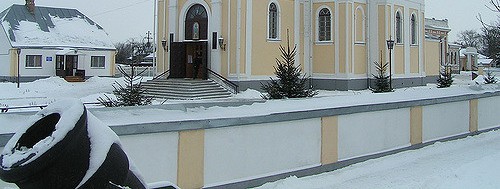Belarus
Climate change Belarus
Present climate
The specific features of the climate are conditioned by the country’s location in the average latitudes, relative proximity of the Atlantic Ocean and prevailing westerly winds that meet no topographical barriers within the country. These conditions contribute to the predominance of the temperate continental climate in Belarus (1).
Mean air temperature in Belarus increases from the northeast (4.5ºC) to the southwest (7.0ºC), mean temperature in January (the coldest month) increases in the same direction from -8.0 to -4.5ºC, and mean temperature in July (the warmest month) increases towards southeast from 17.0 to 18.5ºC (1).
The amount of annual precipitation is, on average, 600 – 700 mm. The warm half-year accounts for approximately 60% of the precipitation. In dry years, the precipitation may reduce to 300 mm, while in humid years it may reach 1,000 mm (1).
The number of days with a stable snow cover varies from 75 in the southwest to 125 in the northeast. The average thickness of the snow layer changes in this direction from 15 to over 30 cm; water capacity of the snow cover respectively changes from 35 to 80-100 mm. Duration of the stable snow cover has been decreasing in the recent decade within the whole country (1).
Air temperature changes until now
The warmest winters were in 1988-1989 and 1989-1990. A continuous long-term series of the warmest winters over the period of instrumental observation (1881-2005) took place between 1989 and 1995, with the average temperature of 1.6°С. Other lasting warm-winter series could be observed in the first half of the 1970s, second half of the 1950s and first half of the 1910s. However for these five-year series the average winter temperature ranged between -2.5 and -3.5°С (1).
Six out of seven highest positive temperature anomalies in the last 100 years happened within the last 20 years. Temperature rise occurred mainly in the first four months of the year. Positive anomaly was maximal in January (about 3,5°С). Summer months turned out to be warmer as well (positive anomaly was +0,7°С in July and +0,8°С in August). Temperature rise is most pronounced in summer in the last decade. Within the last 20 years (1988-2007) there was only one cold winter (1996) (5).
The warming of 1988-2007 resulted in changes in heating season schedule. Its duration, for example, in Minsk decreased by 10-12 days, and average air temperature during a heating season increased by 1,5-1,7°С. Vegetation period started 10 days earlier (5).
Precipitation changes until now
Changes in precipitation during 1990-2005 are more complex by nature. In the north of the country the amount of precipitation continues to increase similar to the previous two decades. Unlike before, in the last decade increased precipitation could be observed in the central and southern parts of Belarus. Recently the precipitation growth has been particularly strong in these regions in January. In spring and June, the amount of precipitation in southern Belarus continues to decrease which produces negative impacts on agricultural production (1,5).
Changes in the annual precipitation course over the last five years (2001-2005) – reduction in precipitation in May-June (especially in the south), rise in precipitation in July-August (especially in the north and centre) – deteriorated conditions for crop development. However in harvesting terms the conditions are more favourable because the amount of September precipitation has been decreasing in the last 15 years. Increasing precipitation in October over 2001-2005 has been conducive to winter crops (1).
Wind climate changes until now
Since the 70-s of the 20th century a reduction in wind speed has been registered in Belarus and in some districts of the European part of Russia and West-Siberia. The reduction in wind speed has been registered during both cold and warm periods of the year (5).
Air temperature changes in the 21st century
Climate change assessments for the first half of this century in Belarus are based on the results of the atmospheric general circulation according to HadCM2 (Great Britain) (2). In the first half of the 21st century a rise in mean temperatures is projected for all months of the year on the average by 0.6-1.9ºСbetween 2010 and 2039 and by 1.0-2.9 ºСsubsequently. The projected temperature increase is most dramatic during winter months (2).
According to calculations based on a regional climate model and two different emission scenarios, wintertime average daily temperatures in the period 2071–2100 are simulated to increase with respect to the period 1961–1990 from 3° to more than 7ºC in east Europe and Russia depending on which emission scenario and which driving global model is used (3). The warming in the cold end of the temperature distribution is even larger. The strongest warming occurs on cold days.
The strong increase in wintertime temperature in east Europe and Russia is probably connected to the reduction of the snow cover in the scenario runs. The mechanisms involved are feedback processes involving temperature, snow cover and albedo. With decreasing snow cover the albedo becomes lower. The lower albedo implies that more shortwave radiation is absorbed in the ground which in turn leads to higher surface temperatures. The largest reduction of the length of the snow season is calculated to be in a zone reaching from central Scandinavia through southern Finland and the Baltic countries and further towards the southeast into Russia (4).
Wind climate changes in the 21st century
Today there are no well-founded forecasts of changes in wind speed in the 21st century (5).
References
The references below are cited in full in a separate map 'References'. Please click here if you are looking for the full references for Belarus.
- Ministry of Natural Resources and Environmental Protection of the Republic of Belarus (2006)
- IPCC/WMO/UNEP (2001), in: Ministry of Natural Resources and Environmental Protection of the Republic of Belarus (2006)
- Räisänen et al. (2003), in: Kjellström (2004)
- Kjellström (2004)
- Ministry of Natural Resources and Environmental Protection of the Republic of Belarus (2009)







